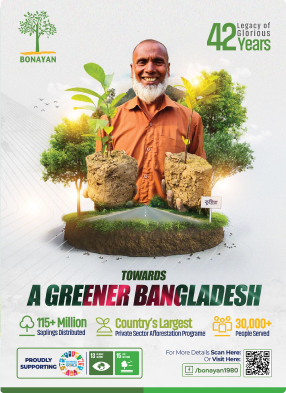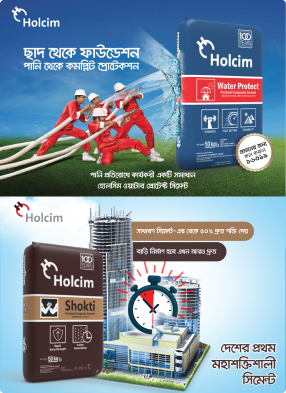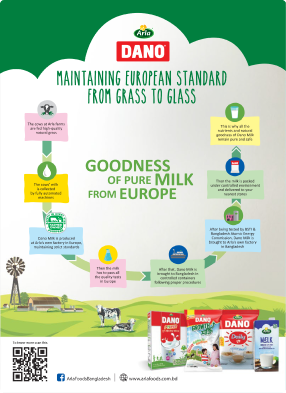- info@ficci.org.bd
- |
- +880248814801, +880248814802
- Contact Us
- |
- Become a Member
- |
- |
- |
- |
- |

When the term Digital Bangladesh was first spoken around the counry most people jested and laughed about it and said it would never come true. But it indeed did. And now, the government aims to elevate the economy to the next level by introducing the ’Smart Bangladesh' concept. The objective is to move beyond digitalization and use technology to improve the standard of living and foster sustainable development.
To better understand the Smart Bangladesh initiative, it’s worth distinguishing between Digital and Smart Bangla- desh. The former involves digitizing processes to facilitate access to information and communication among people. By moving from manual to digital processes, we have created a foundation to transform data into valuable information, and from there into knowledge that can fuel effective solutions. This is the essence of the Digital to Smart Bangladesh vision.
Despite our nation’s considerable progress, some of us remain in denial of our achievements. We fail to see what our neighbors see: that we are pioneers of development. Instead, we often look to the West and make misguided comparisons, preventing us from truly internalizing our success. Smart Bangladesh is not about emulating cities like Singapore, London, or New York, but rather about finding solutions that unlock our full potential and enable us to lead South Asia towards a better future.
Smart Bangladesh Vision 2041 is an all-encompassing ambition centred on inclusivity, prioritizing the people and citizens of Bangladesh. The four pillars are Smart Citizens, Smart Government, Smart Economy, and Smart Society, and they serve as the foundation of the vision. The ultimate goal is to close the digital gap by implementing sustain- able digital solutions accessible to all citizens and businesses, regardless of socio-economic status or size. Building upon the Digital Bangladesh initiative, Smart Bangladesh is the next critical step in realizing the dream of building a Golden Bangladesh
Decentralization: Making the divisional centres become hubs
The concentration of major economic activities in Dhaka has made it one of the world’s most densely populated cities, leading to a prioritization of its development over other cities, ultimately harming the nation as a whole.
Decentralization is therefore essential to achieve Smart Bangladesh and ensure an equitable quality of life across the country. By 2041, it is projected that 80% of Bangladesh’s population will live in cities, and the government has already begun planning to expand urban facilities to rural areas under the "My Village My Town" policy.1 This shift in focus away from Dhaka toward a more balanced development of other urban centers will require the construction of smart transportation systems and improved access to technology, reducing the population’s dependence on Dhaka.
https://www.observerbd.com/news.php?id=402153
Reconnecting the Diaspora in the Western World
Around 13 million Bangladeshis are living abroad in 162 countries. 2 Reconnecting the diaspora in the Western world will help the nation to transfer skills conveniently. Therefore, we need solutions to unleash the potential and reconnecting with the diaspora could help Bangladesh financially and enhance the capability of transferring skillsets.
Diaspora can also act as a catalyst for development by facilitating the transfer of funds, resources, technology, knowledge, skills, and ideas, thereby contributing to economic and social development. According to research by IOM UN Migration, 70,000 to 80,000 diaspora members are potential investors for productive sectors in Bangla- desh, whereas 21,000 to 30,000 diaspora members can contribute to the nation through technological knowledge, skills, and interests.
Diaspora from the Western world already has a positive impact on our nation. In the fiscal year 2019-2020, approxi- mately 13 percent of Bangladeshis living in the USA and UK send 20.7 percent of the total remittances. Not only will reconnecting with the Western world allow the diaspora to contribute to economic development, but it will also allow them to upgrade the skills of the people in the country, which will ultimately help the nation to prosper and progress with Smart Bangladesh’s vision.
Innovation and tech : For sustainable agriculture
Bangladesh’s success relies heavily on the country's increased agricultural productivity. The agriculture sector is one of the centres of the Bangladeshi economy and accounts for around 14 percent of the country’s GDP. In addition, the industry helps to decrease poverty levels, ensures food availability, and has been the primary source of livelihood employment for 41 percent of the labour force.
To achieve Vision 2041 and Sustainable Development Goals (SDG), Bangladesh must harness cutting-edge technol- ogies, market intelligence, and Fourth Industrial Revolution (4IR) tools. Blockchain technology, for instance, can create a digital and verified identity for farmers, containing their credit and transactional history in a distributed network accessible to banks and insurance companies. Meanwhile, Al-based predictive modeling can assist with pricing, market arrivals, local consumption, and exports. By leveraging these advanced technologies, Bangladesh can unlock new opportunities for growth and development.
There are a lot of gaps and untapped opportunities in the agriculture sector; thus, proper initiatives need to be taken to develop and create Smart Agriculture for Smart Economy.
Empowering Entrepreneurs: The Key to Smart Economy in Bangladesh
Entrepreneurs are the catalyst of the economy, both in terms of capital generation and perspective of sustainable development. In the era of the smart economy, modern technologies will lower the barrier to entrepreneurship. Bangladesh's young population has already shown excellent entrepreneurial skills during the pandemic year. For example, a collaboration between UNDP, Bangladesh Government, and a2i, has brought the project called ekshop, which helps a rural eCommerce model that unifies the nationwide physical network of nearly 7,000 Digital Centres.
Moreover, startups have created massive wealth for the economy and themselves globally and are also seen as a critical driver of growth and social equity.
Besides entrepreneurship playing a critical role, the availability of human resources is also necessary for jobs, especially those created during the era of the Smart Economy. There is no shortage of human resources nation- wide; however, skilled workers are lacking, especially in the technology sector. Most jobs in 4IR will be tech-based; hence, Bangladesh needs to upskill its human resources and create appropriate economic employment to succeed in this ever-changing time. The country cannot waste its opportunity anymore to the once-in-a-lifetime window of the demographic dividend and needs to tap into the favourable demographic profile to create an economic power- house.
https://a2i.gov.bd/smart-agriculture-for-smart-bangladesh
Potential to become the next economic hub in South Asia
Bangladesh has the potential to become the next economic hub of South Asia, building on its existing role as a regional logistics and transit hub connecting South and Southeast Asia. According to the Asian Development Bank (ADB), a well-planned infrastructure can position Bangladesh as the gateway for other countries, linking the East and the West. The country’s ambition to become a transport hub is already taking shape, as evidenced by the Biman flight from Dhaka to Canada. Although the initial plan did not include passengers from neighboring countries like Kolkata, their travel to Dhaka for the Canada flight has opened up a new era and presents an opportunity for Bangladesh to leverage this model and become an economic hub for other countries.
Moreover, the western region of Bangladesh shares over 2,000 km with India and is home to major seas and land ports like Mongla, Payra, Benapole, and Bhomra. Our government is already working with the World Bank to refurbish the highways. It will link businesses and consumers, boost trade and consumption, and generate higher income and new jobs. Better connectivity will immensely benefit Bangladesh, enable trade in transport services, and help the nation become South Asia’s regional logistics and transit hub.
According to Global Location Service Index, Bangladesh’s IT sourcing ranks at 21, and the world’s second-largest producer of IT freelancers. 5 Our government is already doing quite a commendable work in this space and has future plans to train 650,000+ registered freelancers to unleash the full potential of the sector. According to the Bangladesh Association of Software and Information Services (BASIS), the IT industry can generate the highest export earnings. Bangladeshi software and IT-enabled services firms already serve clients in over 50 countries globally.^ Bangladesh’s primary export destinations and clients are the USA, Europe, and Japan.
Bangladesh also has the opportunity of becoming Asia’s manufacturing hub. The garment sector already has 4.4 million workers, and the numbers will likely increase with the rise in the future.’ Moreover, the nation’s global-manu- facturing industry is already growing with the increase in intra-regional trade.
Fulfilling the Smart Bangladesh Vision 2041 will help us achieve the nation’s ambitions to become the next hub of South Asia.
Emlsracing the Wind of CAange Smart Bangladesh for A Better Tomorrow
Over the next two decades, experts predict that the world will experience unprecedented change. Some even forecast that humanity will transform more in the next two decades than in history. This transformative wave will undoubtedly impact Bangladesh, and the Smart Bangladesh Vision 2041 will guide the country toward a new era.
Imagine a world where poverty is non-existent, and robots coexist with humans in every service sector, quantum computing is a reality, self-driving cars are ubiquitous, some are even capable of flight, robots handle most manu- facturing, drones are employed in agriculture, and numerous other advancements. The question that begs to be asked is whether Bangladesh is prepared to face this rapidly approaching reality, set to take place globally by 2041.
As a nation of resilient and determined individuals, Bangladesh has overcome countless challenges and has always risen to the occasion when necessary. Nevertheless, we must all work together to achieve the Smart Bangladesh vision and prepare for this advanced world. There is still much to be done, but with proper initiatives and policies, we can help make the concept of Smart Bangladesh a reality.
https://www.dhakatribune.com/bangladesh/2023/04/08/bangladesh-becoming-it-hub-of-south-asia
https://www.dhakatribune.com/bangladesh/2023/04/08/bangladesh-becoming-it-hub-of-south-asia
https://www.thedailystar.net/business/bangladesh-holds-potential-be-asias-manufacturing-hub-130489





